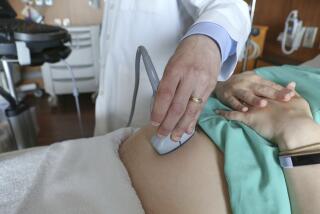High C-section rate may have something to do with impatience
- Share via
Cesarean deliveries have doubled since 1996 and now account for one-third of all births in the United States. A new study suggests that a big dose of patience on the part of women and their healthcare providers during delivery might help to lower the rate substantially.
The study, released Monday by the Eunice Kennedy Shriver National Institute of Child Health & Human Development, found C-section rates were twice as high after induction of labor compared with women undergoing spontaneous labor. Labor is often induced to speed up labor and delivery.
“Our study cannot directly say induction causes C-section, but it does provide some clue that either people may not be patient enough or something is going on that we’re not really sure about,” said the lead author, Dr. Jun Zhang.
The study showed, not surprisingly, that the major reason for undergoing a cesarean was due to the woman having a prior C-section. Still, almost half of the cesareans that took place after labor had started were due to “failure to progress,” and the study suggests that doctors aren’t acknowledging that labor takes time and doesn’t follow a predictable pattern in women, especially first-time mothers. A high proportion of these C-sections were performed before the women’s cervix had dilated to six centimeters, which is still considered an early stage of labor, and among women who had been in active labor for only two or three hours.
“As long as the maternal and fetal health are doing well in labor, they can wait longer and perhaps decrease the cesarean rate,” said Dr. S. Katherine Laughon, a co-author of the study.
The study, on 230,000 deliveries at 19 hospitals across the country, also found that women who tried to have a vaginal birth after cesarean -- or VBAC -- succeeded only 57% of the time. That number is lower than the estimated success rate of 60% to 80% found in other studies.
The study implies the high C-section rate is not being driven by women who are “too posh to push.” Researchers found “truly elective” cesarean delivery accounted for 9.6% of all scheduled C-section and 2.1% of cesareans that occurred after labor had begun.
While doctors and women aren’t giving labor enough time, it’s clear that labor patterns have changed from several generations ago because women today tend to be older, have a larger average body mass index and have bigger babies. While most experts say cesarean rates of 30% or higher are unacceptable, no one really knows what constitutes a reasonable rate based on medical criteria.
For C-section rates to fall, more first-time mothers need to delivery vaginally, Zhang said, and more patients should undergo a trial of labor for VBAC, as was recommended recently by the American College of Obstetricians and Gynecologists.
More information is also need on why doctors are making decisions to induce labor and not allowing more time for a woman to labor naturally.
The study is published online in the American Journal of Obstetrics & Gynecology.
-- Shari Roan / Los Angeles Times
Return to Booster Shots blog.






